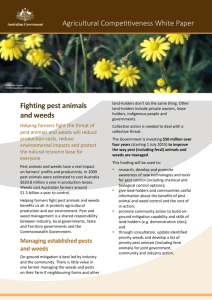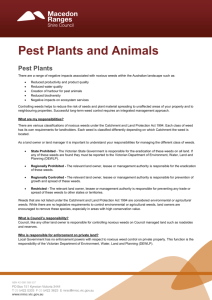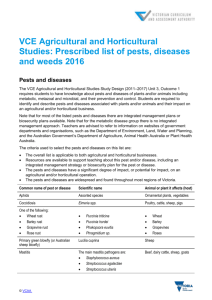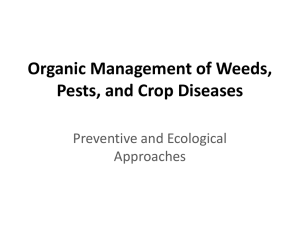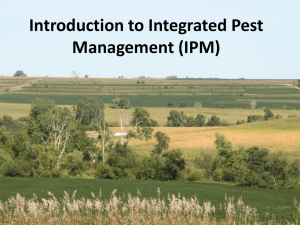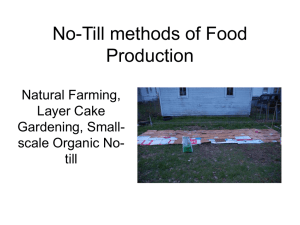Pest and weed Management
advertisement
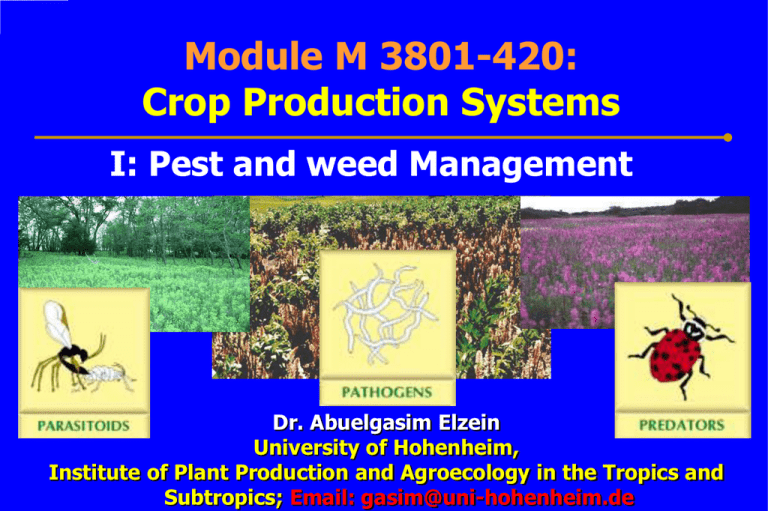
Module M 3801-420: Crop Production Systems I: Pest and weed Management and Dr. Abuelgasim Elzein University of Hohenheim, Institute of Plant Production and Agroecology in the Tropics and Subtropics; Email: gasim@uni-hohenheim.de Contents 1. Yield losses caused by pests, diseases and weeds 2. Pests and diseases of rice and cassava: examples 3. Principles of IPM 4. General aspects of weed control 5. Principles of biological pest and weed control Estimated losses of the 8 most important food- and market-crops1 during the period 1988 - 90, analysed per continent Continent Losses (%)3 Production Total losses ($ billions) (%) Diseases Pests Weed Africa 13,3 4,02 15,6 16,7 16,6 48,9 12,8 North America 50,5 15,1 9,6 10,2 11,4 31,2 23,0 Latin America 30,7 9,2 13,5 14,4 13,4 41,3 21,8 162,9 48,6 14,2 18,7 14,2 47,1 145,3 Europe 42,6 12,7 9,8 10,2 8,3 28,2 16,8 U.S.S.R. 31,9 9,5 15,1 12,9 12,9 40,9 22,1 Ozeania 3,3 1,0 15,2 10,7 10,3 36,2 1,9 335,2 100,0 13,3 15,6 13,1 42,1 Asia Total (%) ($ billions) (Oerke et al., 1994) 1 2 3 Rice, wheat, barley, maize, potatos, soja, cotton, coffee Percental part of the worlproduction Percental part of an achieved production 243,7 Yield losses caused by pests, diseases and weeds Crop Yield losses (%) Diseases Pests Weeds Total Rice 15,1 20,7 15,6 51,4 Wheat 12,4 9,3 12,3 34,0 Barley 10,1 8,8 10,6 29,4 Maize 10,8 14,5 13,1 38,3 Potato 16,4 16,1 8,9 41,4 Soybean 9,0 10,4 13,0 32,4 Cotton 10,5 15,4 11,8 37,7 Coffee 14,9 14,9 10,3 40,0 Mean 12,4 13,8 12,0 38,1 (Oerke et al 1994) Insect pests in rice: Hopper burn – outbreakes of leafhoppers Sogatodes spp. Asia Control: systemic insecticides Insect pests in rice: Rice bug: Leptocorisa oratoria Sucking damage at glumes, shrinking and drying up panicles andg grains Eggs Nymph Control: rotation, planting time Insecticides Adult Cassava - Diseases and pests African mosaic virus Virus transmited by insect (Bemisia tabasi) Symptoms: yellowish leaves Control: 1. Use of rsistance cultivars 2. Chemical and other means of control of the vector instect Strategies in crop protection 1. 2. 3. 4. 5. 6. Preventive measures (plant guarantine) Cultural or agronomical control Physical control Chemical control Biological control Integrated pest mamagement Insect pests in rice: Rice bug: Leptocorisa oratoria Sucking damage at glumes, shrinking and drying up panicles andg grains Eggs Nymph Control: rotation, planting time Insecticides Adult Green rice bug – Nezara viridula Eggs 5. Nymphal stage Adults Definitions of Integrated Pest Management “IPM” FAO definition „A pest management system that, in the context of the associated environment and the population dynamics of the pest species, utilises all suitable techniques and methods in as compatible manner as possible and maintains the pest population at levels below those causing economically unacceptable damage or loss” German Plant Protection Law „A combination of techniques which, giving preference to biological, biotechnological, plantbreeding, cultivation and cropping methods, restricts the application of chemical pesticides to the necessary minimum“ Principles of IPM • IPM is a holistic, interdisciplinary approach which considers the ecological and socioeconomic conditions of a site as one unit, and strives to maintain the productivity of the agroecosystem on a sustainable basis. • Measures to control pest infestation take into account all anticipated ecological, toxicological and economic impacts: preference is given to non-chemical methods over the application of chemical pesticides. What are “weeds”? Weeds are plants that cause more damage than use. “Weeds” are internationally defined as all not desired plant species of very different habitats. Apart from weeds of agricultural crops and pastures or respectively aquatic systems, not desired trees and shrubs of the natural vegetation are defined in this way, too. Why weed control? • Qualitative yield reduction - pollution of harvest products by weed seeds • Quantitative yield reduction - competition for growth factors (nutrients, water, light) Weed competition during the emergence of potatoes Why weed control? • Difficulties concerning cultivation- and harvest labour Flaveria trinerva infestation at potato cropping in the Republic of Yemen Why weed control? • Toxic effect of pasture weeds • Favourable conditions for the transmission of plant diseases and pests -hosts or intermediate host Solanum nigrum parasitized by Orobanche cernua Why weed control? • Displacement of endemic species through accidentally imported plants Eichhornia crassipes Pistia stratiotes Positive effect of weeds • Better soil tilth (tillage), and erosion protection by shading and root penetration of the soil • Support of the beneficial fauna (permanent crops annual crops) Segetal vegetation besides fields in potato production in the Republic of Yemen Positive effect of weeds • Weeds used as additional forage source esp. for smallholder systems of the semi-arid tropics and subtropics Use of Echinops spp. in semi-arid regions of the Republic of Yemen • Weeds as medicinal crops • Weeds as green manure • Weeds as potential genetic pools for crop breeding Instruments for weed control 1. Preventive measures (seed cleaning, crop residues, machines and equipment) 2. Mechanic measures (hoe, harrow, weed harrow) 3. Physical measures (flaming, solarisation) 4. Chemical measures (herbicides) 5. Biological measures (insects, pathogens) Basic components of weed control 1. Identification of weeds and their level of infestation 2. Biology and ecology of the weed species 3. The competitive effects and economic thresholds 4. Technically effective, economically viable and environmentally safe methods of control The most serious weeds in the world Rank 1 2 3 4 5 6 7 8 9 10 11 12 13 14 15 16 17 18 Species Cyperus rotundus L. Cynodon dactylon (L.) Pers Echinochloa curs-galli (L.) P. Beauv. Echinochloa colona (L.) Link Eleusine indica (L.) Gaertn. Sorghum halepense (L.) Pers Imperata cylindrica (L.) Rauschel Eichhornia crassipes (Mart.) Solms Portulaca oleraceae L. Chenopodium album L. Digitaria sanguinalis (L.) Scop. Convolvulus arvensis L. Avena fatua L. and relatives Amaranthus hybridus L. Amaranthus spinosus L. Cyperus esculentus L. Paspalum conjugatum Berg Rottboellia cochinchinensis (Lour.) W.D. Clayton Growth form P P A A A P P P A A A P A A A P P A M M M M M M M D Aq. D D M D M D D M M M * A = annual; Aq = aquatic; D = dicotyledon; M = monocotyledon; P = perennial Module M 3801-420: Crop Production Systems II: Principles of biological pest and weed control and Dr. Abuelgasim Elzein University of Hohenheim, Institute of Plant Production and Agroecology in the Tropics and Subtropics; Email: gasim@uni-hohenheim.de Biological Control •What is Biological Control: definitions •Historical Background •Why is biological control •Principles •Biological control mechanisms •Selected successful examples: –Plant diseases –Insects –Nematodes –weeds What is Biological Control? • Definitions: The utilisation of organisms (micro or macro) for the regulation of plant pests (weeds, diseases, insects, nematodes) densities below the economic threshold. • The use of parasitoids, predators, pathogens and competitors to supress a pest population, making it less abundant and thus less damaging than it would otherwise be. What is Biological Control? A Microbiologist’s Perspective Pest suppression with biological agents operating in a background of integrated control that does not depend on host resistance, sterilization of the target pathogen, or modification of pest behavior. A Practical Perspective Pest suppression with biological agents, derivatives of, or products of biological agents applied in a background of integrated control. Is Biological Control Biotechnology? Biotechnology is a set of tools that utilize living things (and more recently, derivatives of living things) to solve problems or to produce products. Of course it is! Historical Background • The term biological control was first used by Smith (1919) to describe the introduction of exotic natural enemies for the permanat supression of insect pest. • BC was first applied, long before its definition, when man began keeping cats to protect stored grain from damag by rodents. • During the Pre-Scientific Era (Pre – 1880), in China and Yeman colonies of ants were introduced and relaesed in order to control citrus and date pests. • During the 19th century, after microbes were discovered and insects life cycle began to be understood, some attempts were made to use other kind of organisms. A chronology of biological control What Kinds of Things Function as Biological Control Agents? • Microorganisms – Bacteria – Fungi – Nematodes – Viruses • Macroorganisms – Insects – Man – Animals Concept of biological control of pest • To introduce natural enemies of a target pest that will reduce and supress the density of the pest to a level that is acceptable (threshold level). Natural enemies of pests (1) Pathogens (include viruses, bacteria, fungi and protozoa) cause infection diseases in their host which lead to their death. Beauveria infected beetle Natural enemies of pests (2) Parasitoides put the host to death during their development: Egg parasitoids, larval parasitoids, adult and nymphal parasitoids Aphelinus spp. parasitizing an aphid Natural enemies of pests (3) • Predators kill their prey after catching. They need more than one prey for its development. Coccinella septempunctata Where do you find BC agents? • • • • • Suppressive soils Old world New world On plant materials On “sick” pathogens and pests • By accident Suppressive soil: A soil in which certain disease(s) fail to develop because of the presence of microorganisms in the soil antagonistic to the pathogen.


